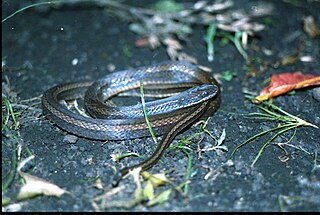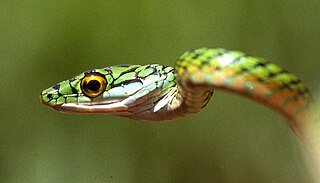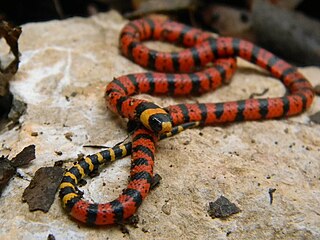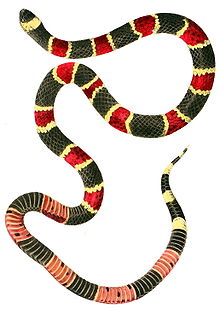
Coral snakes are a large group of elapid snakes that can be divided into two distinct groups, the Old World coral snakes and New World coral snakes. There are 27 species of Old World coral snakes, in three genera, and 83 recognized species of New World coral snakes, in two genera. Genetic studies have found that the most basal lineages have origins in Asia, suggesting that the group originated in the Old World. While new world species of both genera are venomous, their bites are seldom lethal; only two confirmed fatalities have been documented in the past 100 years from the genus Micrurus. Meanwhile, snakes of the genus Micruroides have never caused a medically significant bite.

Boiga is a large genus of rear-fanged, mildly venomous snakes, known commonly as cat-eyed snakes or simply cat snakes, in the family Colubridae. Species of the genus Boiga are native to southeast Asia, India, and Australia, but due to their extremely hardy nature and adaptability, have spread to many other suitable habitats around the world. There are 38 recognized species in the genus. According to the study done by Jiří Smíd regarding Old World cat snakes, the ancestor of the cat snake originated in Africa, from where it diversified and expanded to other countries. Despite this diversity however, the different species have very similar needs in terms of temperature and precipitation.
Lystrophis is the genus of tricolored South American hognose snakes. They mimic milk snakes or coral snakes with their red, black, and white ringed patterns.

Masticophis is a genus of colubrid snakes, commonly referred to as whip snakes or coachwhips, which are endemic to the Americas. They are characterized by having a long, thin body and are not dangerous to humans.

Coniophanes is a genus of colubrid snakes, commonly referred to as black-striped snakes, but they also have many other common names. The genus consists of 17 species, and despite the common name, not all of them display striping.

The Natricinae are a subfamily of colubroid snakes, sometimes referred to as a family (Natricidae). The subfamily comprises 36 genera. Members include many very common snake species, such as the European grass snakes, and the North American water snakes and garter snakes. Some Old World members of the subfamily are known as keelbacks, because their dorsal scales exhibit strong keeling.

The Colubrinae are a subfamily of the family Colubridae of snakes. It includes numerous genera, and although taxonomic sources often disagree on the exact number, The Reptile Database lists 717 species in 92 genera as of September 2019. It is the second largest subfamily of colubrids, after Dipsadinae. Many of the most commonly known snakes are members of this subfamily, including rat snakes, king snakes, milk snakes, vine snakes, and indigo snakes.

Calamaria is a large genus of dwarf burrowing snakes of the family Colubridae. The genus contains 66 recognized species. The genus is endemic to Asia.

Geophis is a genus of snakes in the subfamily Dipsadinae of the family Colubridae of the superfamily Colubroidea. Species in the genus Geophis are commonly referred to as Latin American earth snakes. The genus consists of 53 distinct species.

Leptophis is a genus of colubrid snakes, commonly known as parrot snakes. The species within this genus are widely distributed throughout Mexico, Central and South America.

Oxyrhopus, the false coral snakes, is a genus of colubrid snakes that belong to the subfamily Dipsadinae. The genus is found in Central America and the northern part of South America, and it includes 15 distinct species.

Atractus is a genus of colubrid ground snakes in the subfamily Dipsadinae. The genus includes more than 140 distinct species.

Micrurus diastema, commonly known as the variable coral snake, is a species of venomous snake in the family Elapidae. The species is endemic to southeastern Mexico and northern Central America. There are seven recognized subspecies.

Dipsadinae is a large subfamily of colubroid snakes, sometimes referred to as a family (Dipsadidae). They are found in most of the Americas, including the West Indies, and are most diverse in South America. There are more than 700 species.

Xenodon is a genus of New World snakes in the subfamily Dipsadinae of the family Colubridae.

Micrurus mipartitus is a species of coral snake in the family Elapidae. It is found in South and Central America. The redtail coral snake is common in agricultural areas in Colombia. Its highly neurotoxic venom is known to cause seizures in its prey by activating nerve proteins responsible for seizures within it.















